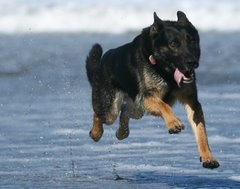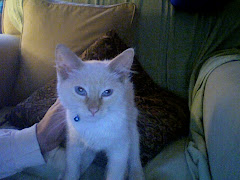
 (Roman and I in the Rally ring)
(Roman and I in the Rally ring)Well, Roman flunked his second attempt at the Canine Good Citizen test...but he flunked with flying colors!
The test consists of 10 parts:
Test 1: Accepting a friendly stranger
The evaluator walks up to the dog and handler and greets the handler in a friendly manner, ignoring the dog. The evaluator and handler shake hands and exchange pleasantries. The dog must show no sign of resentment or shyness, and must not break position or try to go to the evaluator.
Test 2: Sitting politely for petting
This test demonstrates that the dog will allow a friendly stranger to touch it while it is out with its handler. With the dog sitting at the handler's side, to begin the exercise, the evaluator pets the dog on the head and body. The dog must not show shyness or resentment.
This test demonstrates that the dog will allow a friendly stranger to touch it while it is out with its handler. With the dog sitting at the handler's side, to begin the exercise, the evaluator pets the dog on the head and body. The dog must not show shyness or resentment.
Test 3: Appearance and grooming
This practical test demonstrates that the dog will welcome being groomed and examined and will permit someone, such as a veterinarian, groomer or friend of the owner, to do so.
This practical test demonstrates that the dog will welcome being groomed and examined and will permit someone, such as a veterinarian, groomer or friend of the owner, to do so.
Test 4: Out for a walk (walking on a loose lead)
This test demonstrates that the handler is in control of the dog. The dog may be on either side of the handler. The dog's position should leave no doubt that the dog is attentive to the handler and is responding to the handler's movements and changes of direction. there should be a right turn, left turn, and an about turn with at least one stop in between and another at the end.
Test 5: Walking through a crowd
This test demonstrates that the dog can move about politely in pedestrian traffic and is under control in public places. The dog and handler walk around and pass close to several people (at least three). The dog may show some interest in the strangers but should continue to walk with the handler, without evidence of over-exuberance, shyness or resentment. The handler may talk to the dog and encourage or praise the dog throughout the test. The dog should not jump on people in the crowd or strain on the leash.
Test 6: Sit and down on command and Staying in place
This test demonstrates that the dog has training, will respond to the handler's commands to sit and down and will remain in the place commanded by the handler (sit or down position, whichever the handler prefers).
Test 7: Coming when called
The handler will walk 10 feet from the dog, turn to face the dog, and call the dog.
Test 8: Reaction to another dog
This test demonstrates that the dog can behave politely around other dogs. Two handlers and their dogs approach each other from a distance of about 20 feet, stop, shake hands and exchange pleasantries, and continue on for about 10 feet. The dogs should show no more than casual interest in each other. Neither dog should go to the other dog or its handler.
Test 9: Reaction to distraction
This test demonstrates that the dog is confident at all times when faced with common distracting situations. The evaluator will select and present two distractions. Examples of distractions include dropping a chair, rolling a crate dolly past the dog, having a jogger run in front of the dog, or dropping a crutch or cane. The dog may express natural interest and curiosity and/or may appear slightly startled but should not panic, try to run away, show aggressiveness, or bark.
Test 10: Supervised separation
This test demonstrates that a dog can be left with a trusted person, if necessary, and will maintain training and good manners. Evaluators are encouraged to say something like, "Would you like me to watch your dog?" and then take hold of the dog's leash. The owner will go out of sight for three minutes. The dog does not have to stay in position but should not continually bark, whine, or pace unnecessarily, or show anything stronger than mild agitation or nervousness.
When it came to test 8, the evaluator told me, "He can't take ONE step towards the other dog or he flunks. Now relax," Of course, I got all nervous, and that went down the leash to Roman who is so sensitive. We started towards the other dog, the test dog stood up, forged a bit toward Roman with a hard eye...well, Roman got his hackles up and forged with a 'huff' but I was able to get him in a sit, shake hands with the other handler (Roman chilled and looked away) and move off without any further reaction. Still, he didn't pass. But considering the test dog was an intact, protection trained, big German Shepherd male, I think he did great! He aced all the other tests and did great in the rally obedience ring (it was a fun match). Well, they say the third time is the charm and there is another test next month...






No comments:
Post a Comment